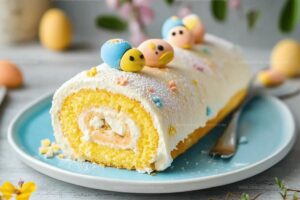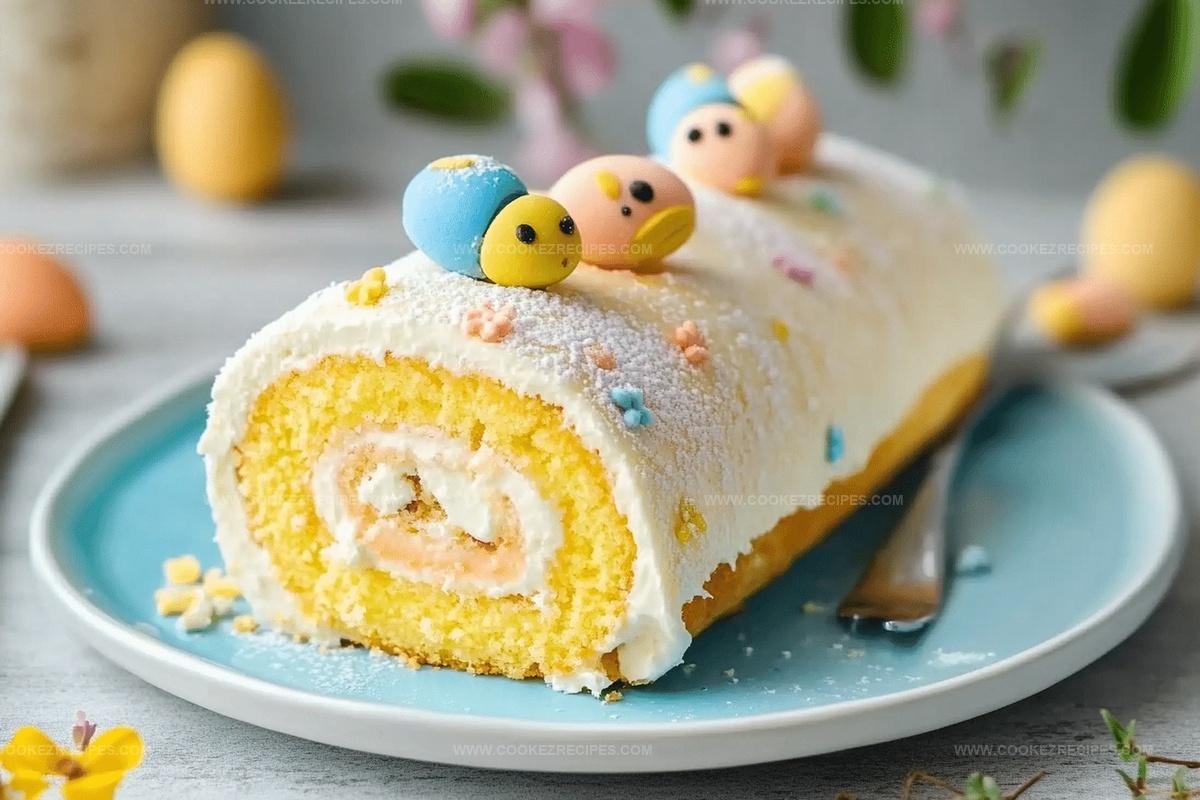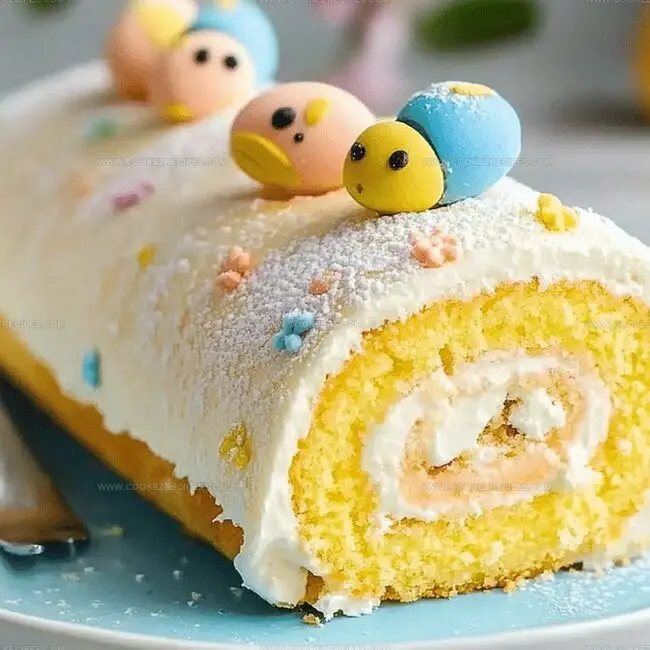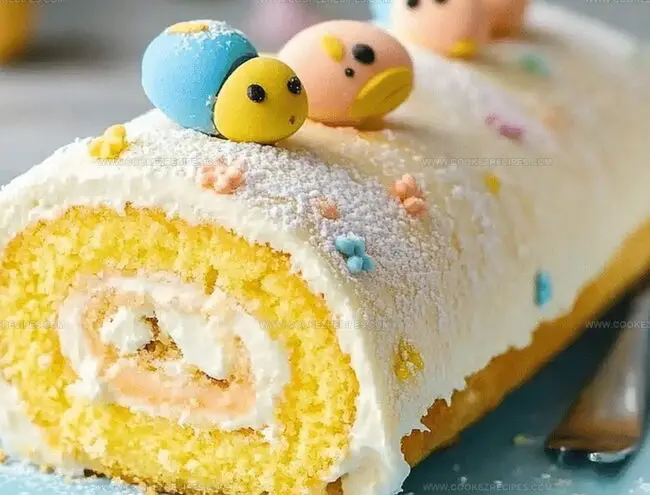Fluffy Easter Cake Roll Recipe: A Spring Treat Everyone Loves
Sweet memories often spiral around a delightful easter cake roll that captures childhood nostalgia in every delicate slice.
Memories of grandma’s kitchen dance through my mind when I think about this classic dessert.
Soft sponge layers whisper stories of springtime celebrations and family gatherings.
Light meringue filling creates a dreamy texture that melts effortlessly on your tongue.
Pastel-colored decorations invite playful moments of joy and connection with loved ones.
Baking this treat connects generations through shared culinary traditions.
You’ll love how simple ingredients can create such a magical centerpiece for your holiday table.
Easter Cake Roll That’s Rolled With Colorful Flavor
Cake Roll Components for Easter Version
Main Cake Roll Components:Liquids and Binding Agents:Buttercream and Decorative Elements:Supporting Ingredients:Easter Cake Roll – Baking and Rolling Instructions
Step 1: Prepare Baking Station
Warm up the oven to 350°F.
Line a cookie sheet with parchment paper.
Ensure all ingredients are at room temperature for smooth mixing.
Step 2: Whip Magical Egg Whites
In a stand mixer, beat egg whites and cream of tartar on medium speed until bubbly.
Slowly sprinkle sugar while mixing.
Increase speed and whip until peaks stand tall and glossy.
Step 3: Create Yolk Mixture
In a separate bowl, whisk egg yolks with milk, oil, and vanilla until smooth.
Sift flour and cornstarch into the mixture, blending until fully incorporated.
Step 4: Combine Delicate Batter
Gently fold one cup of whipped egg whites into the yolk mixture.
Carefully incorporate remaining egg whites to maintain airiness.
The goal is a light, fluffy batter without deflating the whites.
Step 5: Bake Tender Cake
Pour batter into prepared pan, spreading evenly.
Tap pan gently to release any trapped air bubbles.
Bake for 15 minutes until cake springs back when touched.
Step 6: Roll Warm Cake
While cake is still warm, transfer to a clean kitchen towel.
Carefully peel off parchment paper.
Roll cake with towel from short end, creating a gentle spiral.
Allow to cool completely.
Step 7: Prepare Colorful Buttercream
Beat butter and powdered sugar until light and fluffy.
Mix in marshmallow cream for extra smoothness.
Divide into three bowls and create pastel colors using gel food coloring:Step 8: Fill and Reassemble Cake
Unroll cooled cake and trim edges.
Spread buttercream in playful stripes across the surface.
Carefully roll cake back up, ensuring a tight spiral.
Wrap in plastic wrap and chill for 30 minutes.
Step 9: Decorate and Serve
Dust cake with powdered sugar.
Top with adorable Peeps marshmallow candies.
Slice and enjoy your festive Easter treat!
Cake Roll Tips With Easter Color
Cake Roll from Easter Stores Neatly for Seconds
Sweet Picks For Cake Roll
Easter Cake Roll Ideas
FAQs
Egg whites whipped to stiff peaks and carefully folded into the batter create the light, airy texture. Cream of tartar helps stabilize the egg whites, ensuring they rise beautifully without deflating.
Roll the cake while it’s still warm with a towel. This helps the cake stay flexible and prevents cracking. Cool the cake completely in the rolled position to help it maintain its shape.
Yes, you can prepare the buttercream up to 3 days in advance. Store it in an airtight container in the refrigerator. Let it come to room temperature and re-whip before using to restore its fluffy texture.
Use an offset spatula to spread the differently colored buttercream in neat, even stripes. Work slowly and carefully to create clean, distinct color sections inside the cake roll.
Print
Easter Cake Roll Recipe
- Total Time: 50 minutes
- Yield: 12 1x
Description
Sweet memories of childhood spring to life with this classic Easter cake roll, a delightful Swiss roll pastry swirled with creamy filling and adorned with pastel decorations. Perfectly balanced between light sponge and luscious cream, this dessert promises to delight you with its elegant presentation and nostalgic flavor.
Ingredients
Main Ingredients:
- 6 large eggs
- 1 cup (200g) granulated sugar
- 3/4 cup (90g) all-purpose flour
- 1 1/2 cups (340g) salted butter
- 1 1/2 cups (170g) powdered sugar
- 14 ounces (392g) marshmallow cream
Liquid and Binding Ingredients:
- 1/4 cup (60 milliliters) canola oil
- 1/3 cup (80 milliliters) whole milk
- 1 tablespoon (15 milliliters) vanilla extract
Stabilizing and Decorative Ingredients:
- 1/2 teaspoon cream of tartar
- 1 tablespoon cornstarch
- Powdered sugar for dusting
- Gel food coloring (yellow, pink, and blue)
- 3 yellow Peeps
- 2 blue Peeps
- 2 pink Peeps
Instructions
- Prepare the workspace by heating the oven to 350°F (180°C) and lining an 11″x17″ cookie sheet with parchment paper.
- Create a fluffy egg white base by whisking egg whites and cream of tartar on medium speed until frothy. Gradually incorporate sugar, then increase speed to high, whipping until stiff, glossy peaks develop.
- In a separate mixing bowl, blend egg yolks with milk, oil, and vanilla extract. Carefully sift flour and cornstarch into the mixture, stirring until smooth and well-integrated.
- Gently incorporate a cup of the whipped egg white mixture into the yolk base, using a folding technique to maintain the delicate air bubbles.
- Transfer the batter to the prepared pan, ensuring an even distribution and tapping the pan to eliminate any trapped air pockets. Bake for 15 minutes until the surface springs back when lightly touched.
- Immediately after baking, carefully transfer the warm cake onto a clean kitchen towel. Remove the parchment paper and gently roll the cake with the towel, allowing it to cool completely in this rolled position.
- Prepare the buttercream by whipping butter and powdered sugar until light and fluffy. Fold in marshmallow cream, then divide the mixture into three separate bowls. Customize each portion with different gel food coloring for a vibrant effect.
- Once cooled, unroll the cake and trim the edges for a neat appearance. Apply the multicolored buttercream in creative striped patterns, then tightly roll the cake back up. Wrap in plastic wrap and refrigerate for 30 minutes to set.
- Finish the Easter cake roll by dusting with a light layer of powdered sugar and garnishing with festive Peeps marshmallow candies before serving.
Notes
- Stabilize egg whites by adding cream of tartar, ensuring a more stable and voluminous meringue for the cake roll’s light texture.
- Use room temperature eggs to achieve better volume and smoother incorporation when whipping the meringue and mixing batters.
- Control moisture by gently folding ingredients to maintain air bubbles, preventing a dense and tough cake roll texture.
- Customize flavors by experimenting with different extracts like almond or lemon instead of vanilla for a unique Easter dessert twist.
- Prep Time: 35 minutes
- Cook Time: 15 minutes
- Category: Desserts
- Method: Baking
- Cuisine: American
Nutrition
- Serving Size: 12
- Calories: 430
- Sugar: 34g
- Sodium: 320mg
- Fat: 25g
- Saturated Fat: 15g
- Unsaturated Fat: 9g
- Trans Fat: 0g
- Carbohydrates: 46g
- Fiber: 0g
- Protein: 4g
- Cholesterol: 85mg




Daniel Bruns
Founder & Culinary Innovator
Expertise
Recipe development for home cooks, Nutritional analysis and meal planning, Culinary education and food writing
Education
Auguste Escoffier School of Culinary Arts
Diploma in Culinary Arts and Operations
Focus: Classical and contemporary cooking techniques, Culinary entrepreneurship and kitchen management, Menu development and food cost analysis
Daniel’s story started with flour on his face and a pie in the oven at his grandma’s house. He later sharpened his skills at the Auguste Escoffier School of Culinary Arts.
His goal? Recipes so simple you’ll want to cook every night. When he’s not whipping up one-pan wonders, Daniel’s outside picking herbs, hosting neighborhood cook-offs, or baking chocolate cakes with his kids, messy, sweet, and unforgettable.